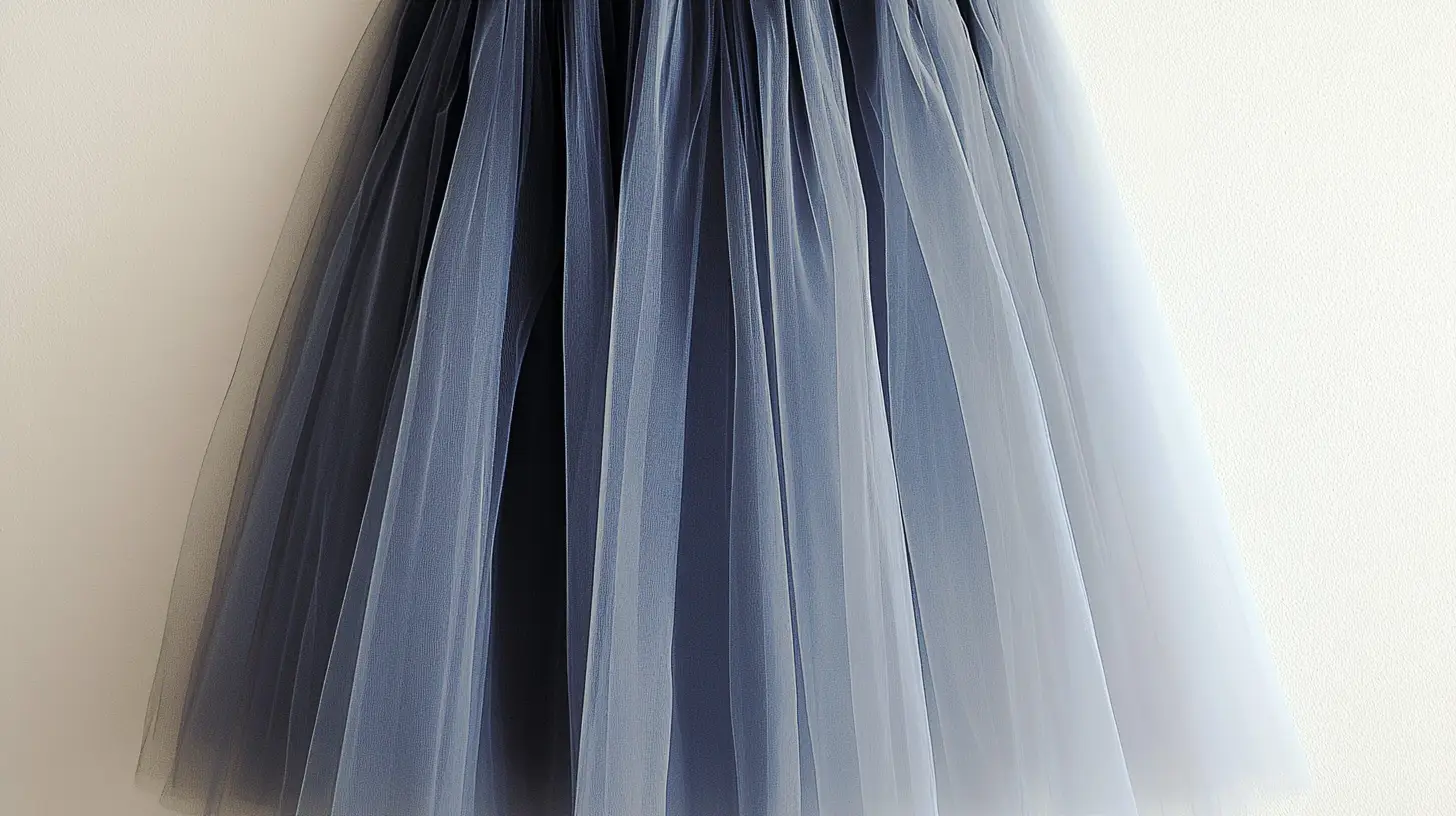Tulle is a lightweight and delicate fabric commonly used in bridal wear, evening gowns, and ballet tutus. Due to its sheer and slippery nature, sewing with tulle can present challenges. However, with the right techniques and tools, you can make tulle garments and accessories beautifully.
In this article, we'll discuss tips and tricks for how to sew with tulle successfully, from choosing the right needle and thread to handling the fabric with care.
Key Takeaways
- Use a sharp needle and lightweight thread to help prevent snagging.
- Secure layers with clips instead of pins to avoid puncturing the fabric.
- Test stitch length on scrap tulle to achieve optimal results.
- Cut tulle precisely with a rotary cutter or sharp scissors.
- Handle tulle gently, using a steamer or low-temperature iron with a press cloth for wrinkles.
Key Features of Tulle Fabric

Tulle fabric is unique because it doesn't fray, allowing you to leave edges unfinished without worry.
This fabric offers excellent stretch and flexibility, especially in the width, making it perfect for various sewing projects.
You'll find different types of tulle fabric, each with varying stiffness and thickness. These cater to specific needs and provide plenty of creative options.
Common Types of Tulle Fabric
Have you ever wondered how many tulle fabrics there are? Here are several common types of tulle.
- Silk Tulle: Luxurious, soft, and expensive. Ideal for bridal veils.
- Nylon Tulle: Durable and affordable. Commonly used for costumes and decorations.
- Polyester Tulle: Sturdy and holds its shape well. Often used in craft projects and home decor.
- Stretch Tulle: Contains spandex for flexibility. Used in dancewear and fitted garments.
- Cotton Tulle: Softer and more breathable. Suitable for children's clothing and casual wear.
- Bridal Illusion: Soft and ideal for veils.
- English Tulle: Offers more structure for petticoats.
Each type varies in thickness and stiffness, catering to different sewing projects and creative needs.
How to Sew With Tulle: 10 Tips and Tricks

When sewing with tulle, it's important to consider a few key factors. Here are ten essential tips for sewing with tulle.
These tips will help you achieve clean and accurate tulle garment sewing, enhancing the overall quality of your tulle project.
1. Use a sharp needle
Always use a sharp needle, such as a size 70/10 or 80/12, to prevent snagging and ensure clean stitches when sewing with tulle.
A sharp needle is crucial for piercing tulle fabric smoothly, allowing you to sew intricate details without causing tears.
The correct needle size ensures your tulle projects turn out beautifully, avoiding skipped stitches or fabric damage.
2. Use a lightweight thread
Pairing a sharp needle with a lightweight thread, such as all-purpose polyester, ensures your tulle projects maintain their delicate and airy quality.
Opt for a lightweight thread to avoid bulkiness and preserve the ethereal look of tulle. This choice enhances smooth sewing and keeps your garment's drape intact.
3. Test your stitch length
Experiment with stitch lengths between 3 and 5 on scrap tulle to find the perfect setting for your project. Test different lengths to see which one gives you optimal results.
Longer stitch lengths often work best, providing a delicate finish and making it easier to gather the tulle.
4. Use clips instead
When you're working with tulle, clips are your best friend for holding everything in place without causing damage.
This delicate, sheer fabric can easily snag or tear with pins. Clips provide a firm hold, keeping your tulle secure as you sew.
They're especially useful for handling multiple layers or intricate designs, ensuring a smooth, successful sewing process.
5. Use a rotary cutter or sharp scissors
When working with tulle, a rotary cutter or sharp scissors are vital for precise and clean cuts. A rotary cutter with a cutting mat provides clean edges and helps avoid fraying.
Sharp scissors also work well to cut tulle, offering accuracy in trimming. To ensure symmetry, cut the tulle while folded.
6. Avoid backstitching
Instead of backstitching, secure the beginning and end of your seam with a knot or by hand-tying the threads to prevent the tulle from bunching up. Backstitching can create bulk and distortion in this delicate fabric, ruining the look.
Hand tying ensures a secure seam without adding visible knots, maintaining the smooth, professional finish that tulle demands.
7. Stabilize the tulle fabric
Stabilizing tulle with a water-soluble stabilizer or tissue paper keeps the fabric from shifting or stretching while you're sewing. These methods ensure your stitches remain precise and prevent puckering.
8. Gather tulle using a water-soluble stabilizer
Using a water-soluble stabilizer makes gathering tulle evenly a breeze. It provides the stability to prevent shifting and bunching during your sewing projects.
Simply place the stabilizer on the tulle, sew your gathers, and watch as it dissolves in water, leaving behind professional-looking gathers.
This method ensures clean, neat results without the hassle of traditional gathering techniques.
9. Hemming Tips
When sewing with tulle, you can skip hemming altogether thanks to its non-fraying edges. This makes working with tulle easier and quicker for your sewing projects.
Unhemmed tulle maintains its delicate, airy look, adding an ethereal touch to garments. By not hemming, you save time and effort, achieving a beautiful, flowing finish that enhances the tulle's lightweight charm.
10. Pressing Tips
While you don't need to hem tulle, it's important to know how to press it properly to maintain its delicate texture.
Use a pressing cloth and set your iron to a low setting. Avoid ironing directly to prevent melting.
Light misting can help reduce static. For the best results, use a garment steamer or press with a towel on top.
Common Problems and Solutions for Sewing Tulle

When sewing with tulle, you might encounter common problems like puckering, static cling, and snags. Let's discover how to solve these problems.
Puckering and how to avoid it
Puckering in tulle is a common issue. But you can avoid it by using a new sharp needle and adjusting your machine's tension settings.
Secure tulle layers with transparent tape to prevent shifting. Experiment with stitch lengths on scrap tulle to find the best settings.
Dealing with static cling
Static cling in tulle can be frustrating, but you can manage it effectively with a few simple techniques.
Combat static cling by lightly misting the tulle with water before sewing.
Avoid directly ironing the tulle; use a pressing cloth on a low setting.
Lastly, use a rotary cutter for precise cuts to prevent shifting.
Fixing snags and tears
Fixing snags and tears in tulle can be straightforward with the right techniques and materials. To mend snags, use a hand-sewing needle and clear fishing line.
Apply a tiny amount of clear nail polish to stop further unraveling. For tears, patch with fabric glue and a small piece of tulle.
Reinforce high-stress areas with extra stitching to prevent future damage.
Final Words
Sewing with tulle can be a breeze if you follow a few key guidelines. Remember to use a sharp needle and lightweight thread, and test your stitch length on a scrap piece.
Clips, a rotary cutter, and precise cutting will make your project smoother. Understanding tulle's characteristics and using the right techniques will help you achieve professional results.
So, don't be intimidated—embrace this delicate fabric and create stunning pieces with confidence!
Learn more sewing tips on the Longan Craft Blog, and dive into the fabric world with Longancraft!
FAQs
What Is the Best Way to Sew Tulle?
Use a rotary cutter and the folding method for neat cuts. Gather tulle with dental floss, mark points with contrasting thread, and spray with anti-static spray. Baste layers together before sewing to ensure a smooth process.
What Kind of Needle Shoule I Use to Sew Tulle?
You should use a universal 80/12 needle or a fine jersey needle size 70/10. A new, sharp needle is crucial to avoid snags. Make sure the needle is appropriate for your tulle's delicacy.
Can I Straight Stitch Tulle?
Yes, you can straight-stitch tulle using a sewing machine. Just use a universal or sharp needle size 60-80/12. Adjust the stitch length to 3-5 and secure the fabric to prevent shifting.
What Is the Best Thread for Tulle?
The best thread for sewing tulle is a fine, all-purpose polyester thread. It's strong and durable and won't snag the delicate fabric. Avoid cotton thread, which can break easily. Always choose a matching color for seamless blending.


0 comments